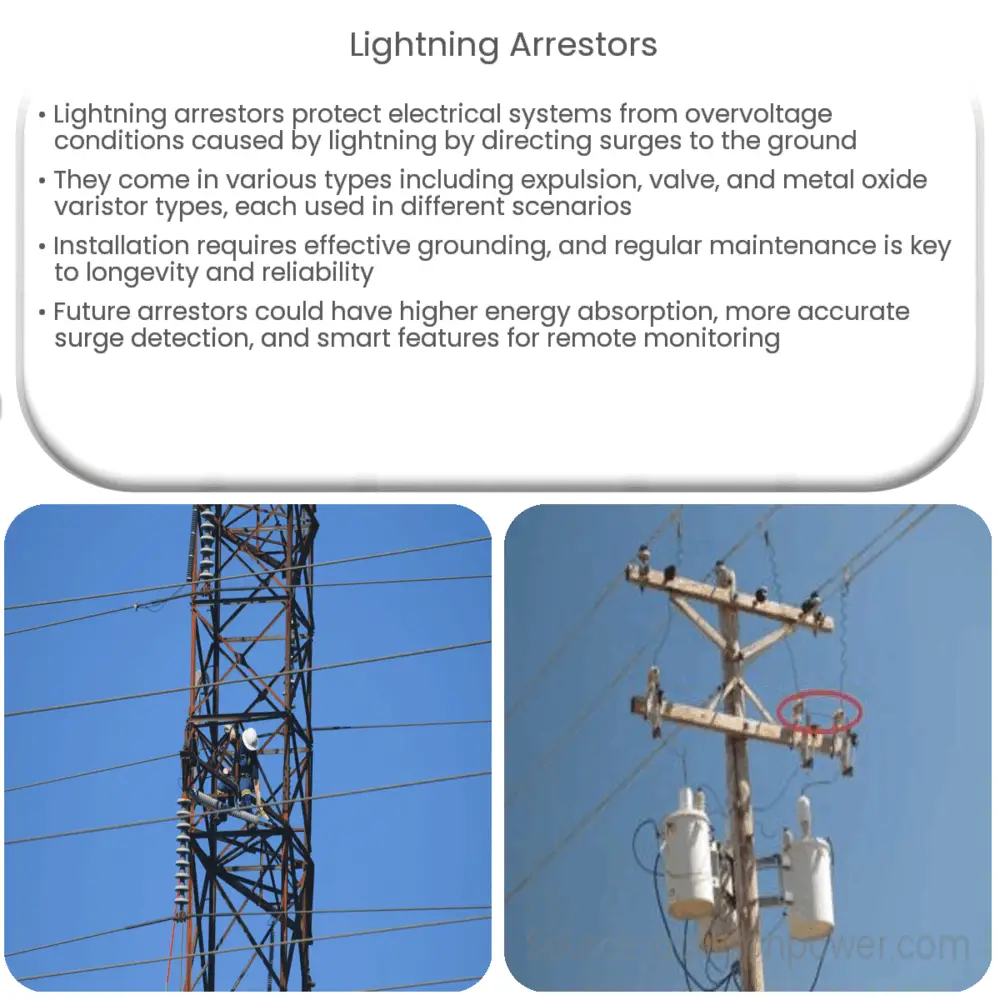Explore the crucial role of lightning arrestors in electrical systems, their working principle, types, maintenance, and future prospects.

Introduction to Lightning Arrestors
Lightning arrestors, also known as surge protectors, play a crucial role in preserving electrical systems from the harmful effects of overvoltage conditions, particularly those caused by lightning. They are a pivotal element in the electrical system’s security framework, protecting numerous electrical devices and preventing disastrous damages and power outages.
The Principle of Lightning Arrestors
Understanding the working principle of a lightning arrestor necessitates a fundamental comprehension of lightning and the surge it can create in an electrical network. When lightning strikes an electrical line, it induces a high voltage surge that can travel along the network, potentially causing extensive damage.
The lightning arrestor functions as a gatekeeper in this situation. It’s designed to identify voltage surges and provide a path for the surge to ground, thereby diverting the destructive energy away from the electrical equipment. As a result, the voltage within the system is maintained at a safe level, protecting the electrical devices connected to it.
Types of Lightning Arrestors
- Expulsion Type Lightning Arrestor: This is a simple, low-cost option commonly used for the protection of distribution lines. It contains a spark gap in series with a resistor.
- Valve Type Lightning Arrestor: Frequently found in substations, this arrestor contains a series of spark gaps in series with a non-linear resistor.
- Metal Oxide Varistor (MOV) Type Lightning Arrestor: This is a modern arrestor type and it uses metal oxide varistors instead of resistors.
Installation of Lightning Arrestors
Lightning arrestors are typically installed on electrical equipment such as transformers and circuit breakers. They are also found on electrical lines, either at the ends or spaced at regular intervals. The installation location is often determined by the type and size of the electrical network, as well as the specific protection requirements.
Proper grounding is essential for the effective operation of a lightning arrestor. The arrestor should be installed in such a way that a direct, low-resistance path to ground is available for the lightning surge. Inadequate grounding can lead to a voltage rise in the ground system, impairing the effectiveness of the arrestor and potentially causing damage.
Maintenance of Lightning Arrestors
Regular maintenance of lightning arrestors is crucial to ensure their reliability and longevity. Maintenance procedures may include periodic inspections for physical damage, contamination, or degradation. In addition, electrical tests, such as insulation resistance tests and current leakage tests, may be performed to assess the arrestor’s functionality.
Application of Lightning Arrestors
Lightning arrestors find extensive applications in the electrical and electronics industry. They are used in power plants, substations, and distribution systems to protect transformers, circuit breakers, and other electrical apparatus. Besides, they are also used in telecommunications, broadcast transmitters, and even in residential buildings to safeguard sensitive electronic equipment from lightning-induced surges.
The Future of Lightning Arrestors
As our reliance on electrical and electronic devices grows, so does the need for effective surge protection. Emerging technologies are offering new possibilities for the design and performance of lightning arrestors. Future arrestors could feature improved materials, offer higher energy absorption capabilities, and provide more accurate surge detection. They may also integrate smart features for remote monitoring and diagnostics, enhancing the overall reliability of the electrical system.
Conclusion
In conclusion, lightning arrestors serve as vital components in protecting our electrical systems from potentially catastrophic lightning-induced surges. They operate on simple yet effective principles, and their proper installation, grounding, and maintenance are paramount for their successful operation. The future of lightning arrestors seems promising, with ongoing advancements aiming to enhance their functionality and efficiency. Thus, a comprehensive understanding of these devices will help us in designing more resilient electrical networks and effectively protecting our technological investments.

